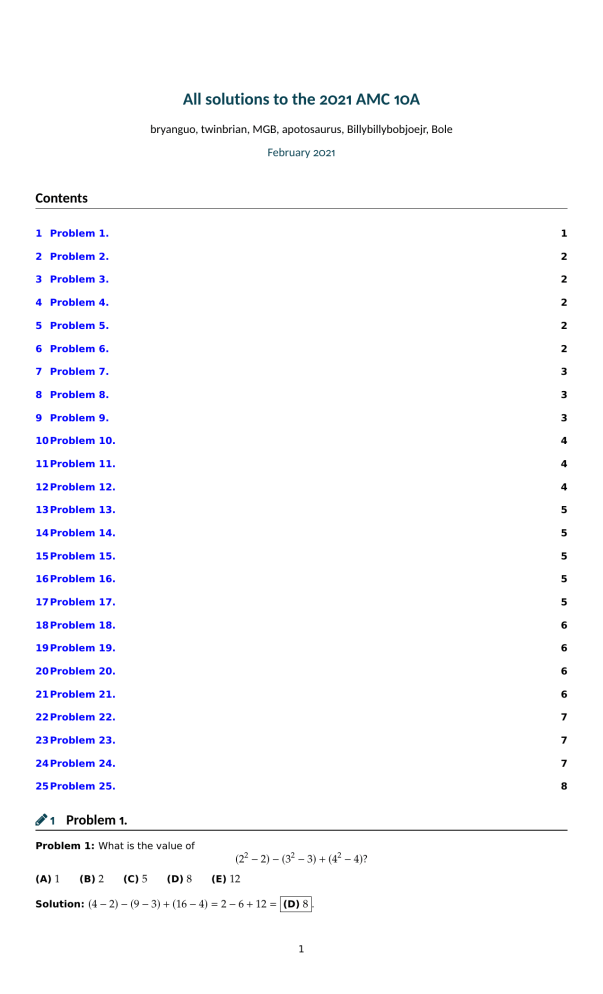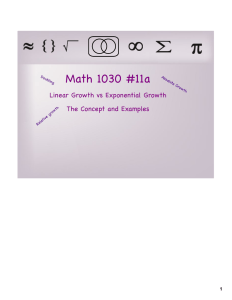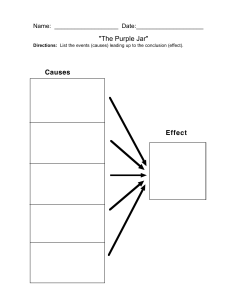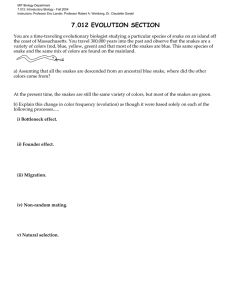
All solutions to the 2021 AMC 10A bryanguo, twinbrian, MGB, apotosaurus, Billybillybobjoejr, Bole February 2021 Contents 1 Problem 1. 1 2 Problem 2. 2 3 Problem 3. 2 4 Problem 4. 2 5 Problem 5. 2 6 Problem 6. 2 7 Problem 7. 3 8 Problem 8. 3 9 Problem 9. 3 10 Problem 10. 4 11 Problem 11. 4 12 Problem 12. 4 13 Problem 13. 5 14 Problem 14. 5 15 Problem 15. 5 16 Problem 16. 5 17 Problem 17. 5 18 Problem 18. 6 19 Problem 19. 6 20 Problem 20. 6 21 Problem 21. 6 22 Problem 22. 7 23 Problem 23. 7 24 Problem 24. 7 25 Problem 25. 8 Ò 1 Problem 1. Problem 1: What is the value of (22 − 2) − (32 − 3) + (42 − 4)? (A) 1 (B) 2 (C) 5 (D) 8 (E) 12 Solution: (4 − 2) − (9 − 3) + (16 − 4) = 2 − 6 + 12 = (D) 8 . 1 Ò 2 Problem 2. Problem 2: Portia’s high school has 3 times as many students as Lara’s high school. The two high schools have a total of 2600 students. How many students does Portia’s high school have? (A) 600 (B) 650 (C) 1950 (D) 2000 (E) 2050 Solution: Let Lara’s high school have 𝑥 amount of students. Then Portia’s school has 3𝑥 students, and 4𝑥 = 2600, meaning there are 𝑥 = 650 students at Lara’s high school. However, we are finding the number of students in Portia’s high school, so our answer is 650 · 3 = (C) 1950 . Ò 3 Problem 3. Problem 3: The sum of two natural numbers is 17,402. One of the two numbers is divisible by 10. If the units digit of that number is erased, the other number is obtained. What is the difference of these two numbers? (A) 10,272 (B) 11,700 (C) 13,362 (D) 14,238 (E) 15,426 Solution: Let the two natural numbers that sum to 17402 be 𝑎 and 𝑏. Let 𝑎 be the natural number which is divisible by 10. This mean 𝑎 = 10𝑥. Notice that 𝑏 = 𝑥 since when the units digit of 10𝑥 is removed, 𝑥 is obtained. So, we know 11𝑥 = 17402, or 𝑥 = 𝑏 = 1582, and also 10𝑥 = 𝑎 = 15820. The answer is 15820 − 1582 = (D) 14,238 . Ò 4 Problem 4. Problem 4: A cart rolls down a hill, travelling 5 inches the first second and accelerating so that during each successive 1-second time interval, it travels 7 inches more than during the previous 1-second interval. The cart takes 30 seconds to reach the bottom of the hill. How far, in inches, does it travel? (A) 215 (B) 360 (C) 2992 (D) 3195 (E) 3242 Solution: The cart starts rolling, traveling 5 inches per second. Each succeeding second, the cart rolls 7 inches added on to the previous second. This means that we will have the cart rolling 5, 12, 19, · · · inches all the way until we reach 30 seconds. Denote our terms, starting off with the first one and ending with the last as 𝑎 1 , 𝑎2 , · · · , 𝑎3 0. By the arithmetic sequence 𝑛 th term formula we obtain 𝑎 𝑛 = 𝑎 1 + (𝑛 − 1)𝑑 =⇒ 𝑎 30 = 5 + (29)7, giving us 𝑎 30 = 208. Hence, we know 𝑎 1 , 𝑎 2 , · · · , 𝑎 𝑛 = 5, 12, · · · , 208. By the sum of an arithmetic sequence formula we obtain 𝑛 𝑎1 + 𝑎 𝑛 5 + 208 = 30 = (D) 3195 . 2 2 Ò 5 Problem 5. Problem 5: The quiz scores of a class with 𝑘 > 12 students have a mean of 8. The mean of a collection of 12 of these quiz scores is 14. What is the mean of the remaining quiz scores of terms of 𝑘 ? (A) 14−8 𝑘−12 (B) 8𝑘−168 𝑘−12 8 (C) 14 12 − 𝑘 (D) 14(𝑘−12) 𝑘2 (E) 14(𝑘−12) 8𝑘 Solution: Notice that if the mean collection of 12 of the quiz scores is 14, then the combined total of everyone’s scores in that group of 12 will be 12 · 14 = 168. We are also given that mean score of everyone’s quizzes is 8𝑘. Thus the total of the remaining people’s scores will be 8𝑘 − 168. From here, it is easy to see that we may divide 8𝑘 − 168 by the number of remaining people to get a mean score of (B) 8𝑘−168 𝑘−12 . Ò 6 Problem 6. Problem 6: Chantal and Jean start hiking from a trailhead toward a fire tower. Jean is wearing a heavy backpack and walks slower. Chantal starts walking at 4 miles per hour. Halfway to the tower, the trail becomes really steep, and Chantal slows down to 2 miles per hour. After reaching the tower, she immediately turns around and descends the steep part of the trail at 3 miles per hour. She meets Jean at the halfway point. What was Jean’s average speed, in miles per hour, until they meet? (A) 12 13 (B) 1 (C) 13 12 24 (D) 13 (E) 2 2 𝐷 𝐷 Solution: Let half the distance of the hill be 𝐷 miles. Therefore, it takes Chantal 𝐷 4 + 2 + 3 hours to climb her portion of the hill until she meets Jean. On the other hand, let Jean hike at 𝐽 miles per hour. Therefore, it takes her 𝐷𝐽 hours to scale half the hill. Because they take the same time, we get the equation 𝐷 𝐷 𝐷 𝐷 + + = . 4 2 3 𝐽 Dividing both sides by 𝐷, we get 1 1 1 13 1 + + = = . 4 2 3 12 𝐽 Therefore, Jean’s desired speed is (A) 12 13 . Ò 7 Problem 7. Problem 7: Tom has a collection of 13 snakes, 4 of which are purple and 5 of which are happy. He knows that: • All of his happy snakes can add • None of his purple snakes can subtract • All of his snakes that can’t subtract also can’t add Which of these conclusions can be drawn about Tom’s snakes? (A) Purple snakes can add. (B) Purple snakes are happy. (C) Snakes that can add are purple. (D) Happy snakes are not purple. (E) Happy snakes can’t subtract. Solution: This problem is less "math-like," and more of testing your logic. Label "All of his happy snakes can add" as (1), "None of his purple snakes can subtract" as (2), and "All of his snakes that can’t subtract also can’t add as (3). Clearly, we see (A) is false because of reasoning with (2) and (3). (B) is not true because purple snakes can’t subtract, and thus they cannot add, but his happy snakes can all add. (C) is false because his purple snakes can’t subtract, and so they can’t add. We finally arrive at a correct choice, which is (D). Purple snakes can’t subtract nor add, while his happy snakes can add and subtract, making this a true statement. We may see (E) is false because of (3). Thus, our final answer is (D) Happy snakes are not purple . Ò 8 Problem 8. Problem 8: When a student multiplied the number 66 by the repeating decimal 1.𝑎𝑏𝑎𝑏 · · · = 1.𝑎𝑏 Where 𝑎 and 𝑏 are digits. He did not notice the notation and just multiplied 66 times 1.𝑎𝑏 . Later he found that his answer is 0.5 less than the correct answer. What is the 2-digit integer 𝑎𝑏 ? (A) 15 (B) 30 (C) 45 (D) 60 (E) 75 𝑎𝑏 Solution: Obviously, a terminating decimal 0.𝑎𝑏, (where 𝑎 and 𝑏 are digits) can be expressed as 100 . Additionally, 𝑎𝑏 it is a well known fact that a repeating decimal 0.𝑎𝑏 · · · can be expressed as 99 . From the problem we know 𝑎𝑏 𝑎𝑏 66 1 + = 66 1 + − 0.5. 100 99 To not confuse us and make it more clear that 𝑎𝑏 is a string of digits and not implied multiplication, let 𝑛 = 𝑎𝑏. Thus we have 66 1 + 𝑛 𝑛 66𝑛 66𝑛 = 66 1 + − 0.5 = 66 + = 66 + − 0.5 100 99 100 99 Combining like-terms and simplifying gives 𝑛 = 0.5, 150 meaning 𝑛 = 75. Recall that we set 𝑛 = 𝑎𝑏, (where 𝑎𝑏 is the string of digits). So our answer is (E) 75 . Ò 9 Problem 9. Problem 9: What is the least possible value of (𝑥 𝑦 − 1)2 + (𝑥 + 𝑦)2 for real numbers 𝑥 and 𝑦 ? (A) 0 (B) 41 (C) 21 (D) 1 (E) 2 Solution: Expand the equation to get 𝑥 2 𝑦 2 − 2𝑥 𝑦 + 1 + 𝑥 2 + 2𝑥 𝑦 + 𝑦 2 = 𝑥 2 𝑦 2 + 𝑥 2 + 𝑦 2 + 1. Now, we employ Simons Favorite Factoring Trick (SFFT) to get (𝑥 2 + 1)(𝑦 2 + 1). By the trivial inequality, 𝑥 2 , 𝑦 2 ≥ 0 and so the minimum value of 𝑥 2 , 𝑦 2 = 0. Therefore, the least possible value of our expression is clearly, (𝑥 2 + 1)(𝑦 2 + 1) = (0 + 1)(0 + 1) = (D) 1 . 3 Ò 10 Problem 10. Problem 10: Which of the following is equivalent to (2 + 3)(22 + 32 )(24 + 34 )(28 + 38 )(216 + 316 )(232 + 332 )(264 + 364 )? (A) 3127 + 2127 (B) 3127 + 2127 + 2 · 363 + 3 · 263 (C) 3128 − 2128 (D) 3128 + 3128 (E) 5127 Solution: Let 𝑥 = 2, 𝑦 = 3 and call our product 𝑆 which turns our equation into 𝑆 = (𝑥 + 𝑦)(𝑥 2 + 𝑦 2 )(𝑥 4 + 𝑦 4 )(𝑥 8 + 𝑦 8 )(𝑥 16 + 𝑦 16 )(𝑥 32 + 𝑦 32 )(𝑥 64 + 𝑦 64 ). A clever method is to collapse the product through telescoping by calculating (𝑥 − 𝑦)𝑆 = (𝑥 − 𝑦)(𝑥 + 𝑦)(𝑥 2 + 𝑦 2 )(𝑥 4 + 𝑦 4 )(𝑥 8 + 𝑦 8 )(𝑥 16 + 𝑦 16 )(𝑥 32 + 𝑦 32 )(𝑥 64 + 𝑦 64 ). Now, by difference of squares, we see (𝑥 − 𝑦)(𝑥 + 𝑦) = 𝑥 2 − 𝑦 2 and (𝑥 2 − 𝑦 2 )(𝑥 2 + 𝑦 2 ) = 𝑥 4 − 𝑦 4 and so on. Therefore, (𝑥 − 𝑦)𝑆 = 𝑥 128 − 𝑦 128 . Since 𝑥 = 2, 𝑦 = 3, we have (2 − 3)𝑆 = −𝑆 = 2128 − 3128 =⇒ 𝑆 = (C) 3128 − 2128 . Ò 11 Problem 11. Problem 11: For which of the following integers 𝑏 is the base-𝑏 number 2021𝑏 − 221𝑏 not divisible by 3? (A) 3 (B) 4 (C) 6 (D) 7 (E) 8 Solution: For this problem, we start off by converting 2021𝑏 − 221𝑏 to base 10. This gives us 2𝑏 3 + 2𝑏 + 1 − (2𝑏 2 + 2𝑏 + 1) = 2𝑏 3 − 2𝑏 2 = 2𝑏 2 (𝑏 − 1). Now, we can test all answer choices (mod 3) to find that only (E) 8 works. Ò 12 Problem 12. Problem 12: Two right circular cones with vertices facing down as shown in the figure below contain the same amount of liquid. The radii of the tops of the liquid surfaces are 3 cm and 6 cm. Into each cone is dropped a spherical marble of radius 1 cm, which sinks to the bottom and is completely submerged without spilling any liquid. What is the ratio of the rise of the liquid level in the narrow cone to the rise of the liquid level in the wide cone? Figure 1: Cones (A) 1 : 1 (B) 47 : 43 (C) 2 : 1 (D) 40 : 13 (E) 4 : 1 Solution: Recall that the volume of a cone is determined by 𝜋𝑟 2 3ℎ , where 𝑟 is the radius, and ℎ is the height of the cone. Thus, plugging in respective radius’s 3 and 6 (left cone and right cone) into the formula gives 9𝜋 3ℎ : 36𝜋 3ℎ =⇒ 3𝜋ℎ : 12𝜋ℎ =⇒ 1 : 4.. This means the "shaded" cone on the left has radius 3 and height 4ℎ and the "shaded" cone on the right has a radius of 6 and a height of ℎ . Since when we drop in the marble we will still have similar cones our answer is just 4ℎ : ℎ =⇒ (E) 4 : 1 . 4 Ò 13 Problem 13. Problem √ 13: What is the volume of tetrahedron 𝐴𝐵𝐶𝐷 with edge lengths 𝐴𝐵 = 2, 𝐴𝐶 = 3, 𝐴𝐷 = 4, 𝐵𝐶 = 𝐵𝐷 = 2 5, and 𝐶𝐷 = 5 ? √ (A) 3 (B) 2 3 √ 13, √ (C) 4 (D) 3 3 (E) 6 Solution: We examine our tetrahedron for existing right angle triangle formations. Clearly, 4𝐴𝐶𝐷 is right- √ 2 angled,√ with lengths 3 − 4 − 5. Furthermore, notice 22 + 32 = 13 ,√so 4𝐴𝐵𝐶 is right-angled, with lengths 2 − 3 − 13. Finally, notice that 4𝐴𝐵𝐷 is right-angled, since 22 + 42 = (2 5)2 . It is clear our tetrahedron’s volume can be calculated by 13 𝑏 ℎ = 31 · 2·4 2 · 3 = (C) 4 . Ò 14 Problem 14. Problem 14: All the roots of polynomial 𝑧 6 − 10𝑧 5 + 𝐴𝑧 4 + 𝐵𝑧 3 + 𝐶𝑧 2 + 𝐷𝑧 + 16 are positive integers, possibly repeated. What is the value of 𝐵? (A) − 88 (B) − 80 (C) − 64 (D) − 41 (E) − 40 Solution: Using Vieta’s Formula, we find that the sum and product of the roots are 10 and 16 respectively. There are in fact a few solutions to this. Since we know all the roots must be positive solutions, we may see the sextuplet 1, 1, 2, 2, 2, 2 works. Taking this case, we find (𝑧 − 1)2 (𝑧 − 2)4 . We desire to find the 𝑧 3 term. If we chose to have all the 𝑧 powers created from the term (𝑧 − 2)4 , we have 43 · −2 · (−1)2 = −8. If we chose one 𝑧 termin the (𝑧 − 1)2 factor, then the remaining two powers of 𝑧 must be created in the (𝑧 − 2)4 factor. This gives 2 4 us 1 · 2 · −1 · (−2)2 = −48. Finally, if we chose to use both 𝑧 powers in (𝑧 − 1)2 and one in (𝑧 − 2)4 , we have 4 1 · (−2)3 = −32. Thus, −8 − 48 − 32 = (A) − 88 Ò 15 Problem 15. Problem 15: Values for 𝐴, 𝐵, 𝐶, and 𝐷 are to be selected from 1, 2, 3, 4, 5, 6 without replacement (i.e. no two letters have the same value). How many ways are there to make such choices so that the two curves 𝑦 = 𝐴𝑥 2 + 𝐵 and 𝑦 = 𝐶𝑥 2 + 𝐷 intersect? (The order in which the curves are listed does not matter; for example, the choices 𝐴 = 3, 𝐵 = 2, 𝐶 = 4, 𝐷 = 1 is considered the same as the choices 𝐴 = 4, 𝐵 = 1, 𝐶 = 3, 𝐷 = 2.) (A) 30 (B) 60 (C) 90 (D) 180 (E) 360 Solution: Note that if 𝐴 > 𝐶 and 𝐵 > 𝐷 or 𝐴 < 𝐶 and 𝐵 < 𝐷 , the curves will not intersect. Now, consider all groups of 𝐴, 𝐵, 𝐶, 𝐷 . There are 64 ways to choose the unordered set 𝐴, 𝐵, 𝐶, 𝐷 , and 42 ways to choose which two are 𝐴 and 𝐶 . Note that if 𝐴 > 𝐶 , there is only one way to choose 𝐵 and 𝐷 , that is such that 𝐵 < 𝐷 . Similarly, if 𝐴 < 𝐶 , then 𝐵 > 𝐷 . Since 𝐴 and 𝐶 uniquely define the order of 𝐵 and 𝐷 , the final answer is 6 4 · = 15 · 6 = (C) 90 . 4 2 Ò 16 Problem 16. Problem 16: In the following list of numbers, the integer 𝑛 appears 𝑛 times in the list for 1 ≤ 𝑛 ≤ 200. 1, 2, 2, 3, 3, 3, 4, 4, 4, 4, · · · , 200, 200, ·, 200 What is the median of the numbers in this list? (A) 100.5 (B) 134 (C) 142 (D) 150.5 (E) 167 201(200) Solution: Notice that the total number of terms in this sequence is 1+2+3+· · ·+200 = = 201∗100 = 20100. 2 Thus, the middle two numbers are the 10050 and 10051st numbers in this sequence. Thus, we desire to find 𝑛(𝑛+1) some 𝑛 such that = 10050, 10051. This gives us 𝑛 ∈ (141, 142). We take the ceiling of this, as the value 2 exceeds 𝑛 = 141, so our answer is 142 for both values, making our median (C) 142 . Ò 17 Problem 17. Problem 17: Trapezoid 𝐴𝐵𝐶𝐷 has 𝐴𝐵 k 𝐶𝐷 , 𝐵𝐶 = 𝐶𝐷 = 43, and 𝐴𝐷 ⊥ 𝐵𝐷 . Let 𝑂 be the intersection of the diagonals 𝐴𝐶 and 𝐵𝐷 , and let 𝑃 be the midpoint of 𝐵𝐷 . Given that 𝑂𝑃 = 11, the length 𝐴𝐷 can be written in √ the form 𝑚 𝑛 , where 𝑚 and 𝑛 are positive integers and 𝑛 is not divisible by the square of any prime. What is 𝑚 + 𝑛? 5 (A) 65 (B) 132 (C) 157 (D) 194 (E) 215 Solution: We see that since 4𝐵𝐶𝐷 is isosceles, 𝐶𝑃 ⊥ 𝐵𝐷 . Let us apply a flurry of similar triangles. In particular, note that 4𝐶𝑃𝐷 ∼ 4𝐴𝐷𝐵 and 4𝐶𝑃𝑂 ∼ 𝐴𝐷𝑂 by the parallel sides condition. Furthermore, 𝐷𝑃 = 𝐵𝑃 , so we have that the ratio for the first pair of similar triangles is 1 : 2. This gives us 𝐴𝐵 = 86. Let 𝐷𝑃 = 𝑥 . 𝑥+11 We obtain 𝐷𝑂 = 𝑥 − 11. Since 4𝐴𝑂𝐵 ∼ 4𝐶𝑂𝐷 we get the equation 86 43 = 𝑥−11 . Solving gets us 𝑥 = 33. By the Pythagorean Theorem 𝐴𝐷 = √ √ 862 − 662 = 4 190. Thus, our answer is 4 + 190 = (D) 194 . Alternatively√(Proceeding off of p the 𝐷𝑂 = 𝑥 − 11 √): Furthermore, by the Pythagorean Theorem, we obtain 𝐶𝑃 = √ 432 − 𝑥√2 = 1849 − 𝑥 2 , 𝐴𝐷 = 862 − (2𝑥)2 = 7396 − 4𝑥 2 . By using the latter similar triangles condition, we √ 2 11 obtain √ 1849−𝑥 2 = 𝑥−11 =⇒ 𝑥 = 33. Finally, this gives us 𝐴𝐷 = 4 190. Thus, our answer is 4 + 190 = (D) 194 . 7396−4𝑥 Ò 18 Problem 18. Problem 18: Let 𝑓 be a function defined on the set of positive rational numbers with the property that 𝑓 (𝑎 · 𝑏) = 𝑓 (𝑎) + 𝑓 (𝑏) for all positive rational numbers 𝑎 and 𝑏 . Suppose that 𝑓 aso have the property that 𝑓 (𝑝) = 𝑝 for every prime number 𝑝 . For which of the following numbers 𝑥 is 𝑓 (𝑥) < 0? (A) 17 32 (B) 11 16 (C) 79 (D) 76 (E) 25 11 Solution: Firstly, we note that we must get rid of the denominators somehow. Let us proceed to check each 17 individual case. For 𝐴, we have 𝑓 ( 17 32 · 32) = 𝑓 (17) = 𝑓 ( 32 ) + 𝑓 (32) by the property of 𝑓 . Furthermore, by 17 the properties of 𝑓 we have that 𝑓 (17) = 17. Thus, 𝑓 ( 32 ) = 17 − 𝑓 (32). Repeatedly applying the property 𝑓 (𝑎 · 𝑏) = 𝑓 (𝑎) + 𝑓 (𝑏) gives us 𝑓 (32) = 𝑓 (2) + 𝑓 (16) = 2 𝑓 (2) + 𝑓 (8) = 3 𝑓 (2) + 𝑓 (4) = 5 𝑓 (2), which is finally 10. 11 7 7 Plugging this in, we see 𝑓 ( 17 32 ) = 7 > 0, a contradiction. Likewise, 𝑓 ( 16 ) = 3, 𝑓 ( 9 ) = 1, 𝑓 ( 6 ) = 2, which all do not 25 25 work. We check 𝑓 ( 25 11 ), and applying a similar routine yields 𝑓 ( 11 ) = −1 < 0, as desired. Our answer is (E) 11 . Ò 19 Problem 19. Problem 19: The area of the region bounded by the graph of 𝑥 2 + 𝑦 2 = 3|𝑥 − 𝑦| + 3|𝑥 + 𝑦| is 𝑚 + 𝑛𝜋, where 𝑚 and 𝑛 are integers. What is 𝑚 + 𝑛 ? (A) 18 (B) 27 (C) 36 (D) 45 (E) 54 Solution: It is worth to note that considering signs a very ideal in absolute value graphs. If we took both to be positive, we have 𝑥 2 + 𝑦 2 − 6𝑥 = 0 =⇒ (𝑥 − 3)2 + 𝑦 2 = 32 . Similarly, using all four combinations of negative and positive, we have (𝑥 + 3)2 + 𝑦 2 = 32 , 𝑥 2 + (𝑦 − 3)2 = 32 , 𝑥 2 + (𝑦 + 3)2 = 32 . Graphing all these four circles gives us a figure with a square and four semicircles with diameter as the side lengths of the square. The radius of each circle is 3, so the side length of the square. Calculating the area gives us 36 + 18𝜋, so our answer is (E) 54 . Ò 20 Problem 20. Problem 20: In how many ways can the sequence 1, 2, 3, 4, 5 be rearranged so that no three consecutive terms are increasing and no three consecutive terms are decreasing? (A) 10 (B) 18 (C) 24 (D) 32 (E) 44 Solution: We see that if 1 was the leading number in the sequence, we have 1+2+2 = 5 ways(each correspond to the case of 3, 4, 5 as the second leading number). If 2 was the leading number in the sequence, we have 1 + 2 + 2 + 2 = 7. Similarly, if 3 was the leading number in the sequence, we have 2 + 2 + 2 + 2 = 8. For 4 and 5, they are symmetrical to case 2 and case 1, so our answer is simply 5 + 7 + 8 + 7 + 5 = (D) 32 Ò 21 Problem 21. Problem√21: Let 𝐴𝐵𝐶𝐷𝐸𝐹 be an equiangular hexagon. The lines 𝐴𝐵, 𝐶𝐷, and √ 𝐸𝐹 determine a triangle with area 192 3, and the lines 𝐵𝐶, 𝐷𝐸, and 𝐹𝐴 determine a triangle with area 324 3. The perimeter of hexagon √ 𝐴𝐵𝐶𝐷𝐸𝐹 can be expressed as 𝑚 + 𝑛 𝑝 , where 𝑚, 𝑛, and 𝑝 are positive integers and 𝑝 is not divisible by the square of any prime. What is 𝑚 + 𝑛 + 𝑝 ? (A) 47 (B) 52 (C) 55 (D) 58 (E) 63 6 Solution: Note that because the angles of an equiangular hexagon are all 120 √ degrees, the two triangles that the hexagon is inscribed in are equilateral and have side lengths 36 and 16 3. Also note that each of 3 side lengths of both triangles is the sum of 3 sides of the hexagon. Each side length will occur 3 times (each side length contributes once to the side of one of the equilateral triangle it is on and twice to the other equilateral triangle). Thus if we√sum up the 6 equations from each √ side length of the equilateral triangles we get 3· perimeter = 3 · 36 + 3 · 16 3, so the perimeter is just 36 + 16 3 =⇒ (C) 55 . Ò 22 Problem 22. Problem 22: Hiram’s algebra notes are 50 pages long and are printed on 25 sheets of paper; the first sheet contains pages 1 and 2, the second sheet contains pages 3 and 4, and so on. One day he leaves his notes on the table before leaving for lunch, and his roommate decides to borrow some pages from the middle of the notes. When Hiram comes back, he discovers that his roommate has taken a consecutive set of sheets from the notes and that the average (mean) of the page numbers on all remaining sheets is exactly 19. How many sheets were borrowed? (A) 10 (B) 13 (C) 15 (D) 17 (E) 20 Solution: Let 𝑥 be the number of the first page his roommate gets and 𝑘 be the number of notes he takes. We obtain 1275 − 𝑘(2𝑥 + 2𝑘 − 1) = 19(50 − 2𝑘) =⇒ 325 = 𝑘(2𝑥 + 2𝑘 − 39). We take the factors of 325, which are 5 and 13. If we pick 5, then his roommate takes notes that exceed the last page. Thus, our answer is (B) 13 . Ò 23 Problem 23. Problem 23: Frieda the frog begins a sequence of hops on a 3 × 3 grid of squares, moving one square on each hop and choosing at random the direction of each hop-up, down, left, or right. She does not hop diagonally. When the direction of a hop would take Frieda off the grid, she "wraps around" and jumps to the opposite edge. For example if Frieda begins in the center square and makes two hops "up", the first hop would place her in the top row middle square, and the second hop would cause Frieda to jump to the opposite edge, landing in the bottom row middle square. Suppose Frieda starts from the center square, makes at most four hops at random, and stops hopping if she lands on a corner square. What is the probability that she reaches a corner square on one of the four hops? 9 (A) 16 (B) 58 (C) 34 (D) 25 32 (E) 13 16 Solution: We proceed with a few cases. If we reach a corner in two moves, we have a probability of 12 . To see why, Frieda can move in any direction for the first move. For the second move, Frieda is surrounded by two corners, so it has a 12 probability of moving to the corners. If it reaches a corner in three moves, Frieda is forced to do a "wrap around." In particular, note that in the first move, it again can move in any direction. The second move must be in the identical direction as the first move, giving us 14 of a probability. The third move has a 1 1 2 probability(with the same reasoning as case 1). We have 8 for this case. Finally, if it reaches a corner in 4 moves, we have two subcases. If the second move is the exact opposite of the first move, then the third and fourth move probabilities are identical to case 1. An example is Frieda going North, then South. Effectively, this just resets it back to the center. We have this as 14 · 12 = 18 . The other subcase is if it "wraps around" twice. 1 . Adding up all our cases gives us An example is North, North, South, and West/East. This gives us 14 · 14 · 12 = 16 1 2 + 1 8 + 1 8 + 1 32 = (D) 25 32 Ò 24 Problem 24. Problem 24: The interior of a quadrilateral is bounded by the graphs of (𝑥 + 𝑎 𝑦)2 = 4𝑎 2 and (𝑎𝑥 − 𝑦)2 = 𝑎 2 , where 𝑎 a positive real number. What is the area of this region in terms of 𝑎 , valid for all 𝑎 > 0? 8𝑎 2 (A) (𝑎+1) 2 4𝑎 (B) 𝑎+1 8𝑎 (C) 𝑎+1 2 (D) 𝑎8𝑎 2 +1 (E) 𝑎 28𝑎+1 2 Solution: Note, that if one plugged in 𝑎 = 2, it becomes clear by using Shoelace Theorem that (D) 𝑎8𝑎 2 +1 is the only solution. This is a very common technique for problems like such. As a remark, by slopes, one may see the figure formed is actually a rectangle. If one were to bash this, the forms for 𝑥 would be very ugly, so we would not advice this. 7 Ò 25 Problem 25. Problem 25: How many ways are there to place 3 indistinguishable red chips, 3 indistinguishable blue chips, and 3 indistinguishable green chips in the squares of a 3 × 3 grid so that no two chips of the same color are directly adjacent to each other, either vertically or horizontally. (A) 12 (B) 18 (C) 24 (D) 30 (E) 36 Solution: Label red as 𝑅 , blue as 𝐵, and green as 𝐺 . We casework on the center square. If the center square is 𝑅 , we must have the remaining two 𝑅 s at the four corners. This gives us 42 = 6 combinations. The remaining three 𝐵s and 𝐺 s have 2 ways. Thus, for each center square case, we have 6 ∗ 2 = 12. The center square is symmetrical for 𝑅, 𝐵, 𝐺 , and our answer is (E) 36 . 8



